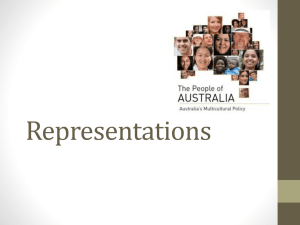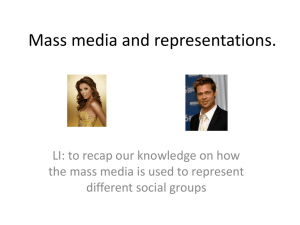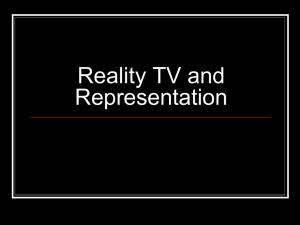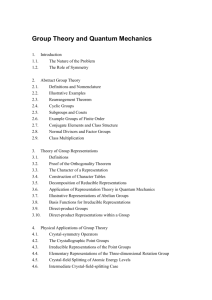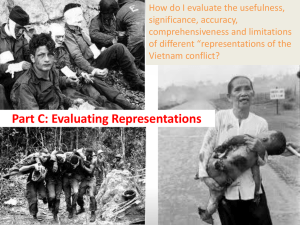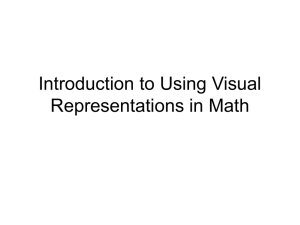Gender - St Mary`s High School
advertisement
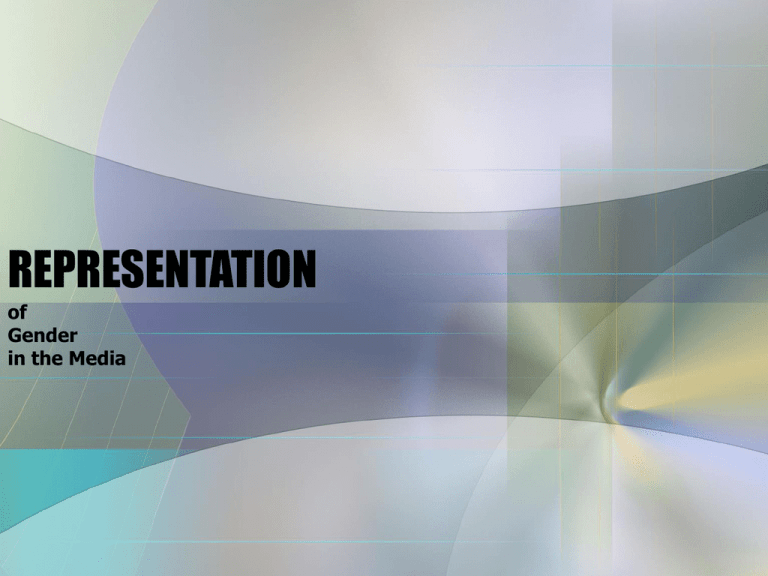
REPRESENTATION of Gender in the Media All media texts are re-presentations of reality. • They are entirely constructed versions of reality. • When studying the media it is vital to remember this - every media form, from a home video to a glossy magazine, is a representation of someone's concept of existence, encoded into a series of signs and symbols which can be read by an audience. • However, it is important to note that without the media, our perception of reality would be very limited, and that we, as an audience, need these artificial texts to mediate our view of the world; in other words we need the media to make sense of reality. • Therefore, representation is a fluid, two-way process: producers position a text somewhere in relation to reality and audiences assess a text on its relationship to reality. Extension/Restriction of Experience of Reality • By giving audiences information, media texts extend experience of reality. • Every time you see a media text, you extend your experience of life but in a second-hand way (vicarious). • However, because the producers of the media text have selected and constructed the information we receive, then our experience is restricted. Truth or Lies? • Media representations - and the extent to which we accept them - are a very political issue, as the influence the media exerts has a major impact on the way we view the world. By viewing media representations our prejudices can be reinforced or confronted. • Generally, audiences accept that media texts are fictional to one extent or another - we have come a long way from the mass manipulation model of the 1920s and 1930s (the hypodermic needle effect). However, as we base our perception of reality on what we see in the media, it is dangerous to suppose that we don't see elements of truth in media texts either. The study of representation is about decoding the different layers of truth/fiction/whatever. In order to fully appreciate the part representation plays in a media text you must consider • • • • Who produced it? • What/who is represented in the text? • How is that element represented? • Why was this particular representation (this shot, framed from this angle, this story phrased in these terms, etc) selected, and what might the alternatives have been? • What frame of reference does the audience use when understanding the representation? Gender • Gender is one of the basic categories we use for sorting human beings, and it is a key issue when discussing representation (along with race, culture, age etc.). • Essential elements of our own identity, and the identities we assume other people to have, come from concepts of gender - what does it mean to be a boy or a girl? • Many objects, not just humans, are represented by the media as being particularly masculine or feminine - particularly in advertising - and we grow up with an awareness of what constitutes 'appropriate' characteristics for each gender. • Or cultural ideas of gender. You can construct your own table of 'typical' male/female characteristics, as perpetuated by the media. Try to list at least ten for each. Typically masculine Typically feminine Tough Fragile Hard Soft Sweaty Fragrant How might the following objects be 'gendered' through advertising, given that both sexes will use the product? a sports car cigarettes a diving watch bottled beer toilet paper a a hi-fi trainers games system console deodorant an airline Representations of Femininity • Feminism has been a recognised social philosophy for more than thirty years, and the changes that have occurred in women's roles in western society during that time have been nothing short of phenomenal. Yet media representations of women remain worryingly constant. Does this reflect that the status of women has not really changed or that the male-dominated media does not want to accept it has changed? • Representations of women across all media tend to highlight the following: • beauty (within narrow conventions) • size/physique (again, within narrow conventions) • sexuality (as expressed by the above) • emotional (as opposed to intellectual) dealings • relationships (as opposed to independence/freedom) Representations of Femininity (2) • Women are often represented as being part of a context (family, friends, colleagues) and working/thinking as part of a team. • In drama, they tend to take the role of helper (Propp) or object, passive rather than active. • Often their passivity extends to victim-hood. – Men are still represented as TV drama characters up to 3 times more frequently than women, and tend to be the predominant focus of news stories. • The representations of women that do make it onto page and screen do tend to be stereotypical, in terms of conforming to societal expectations, and characters who do not fit into the mould tend to be seen as dangerous and deviant. Representations of Masculinity • 'Masculinity' is a concept that is made up of more rigid stereotypes than femininity. Representations of men across all media tend to focus on the following: • Strength - physical and intellectual • Power • Sexual attractiveness (which may be based on the above) • Physique • Independence (of thought, action) Representations of Masculinity • • • • • • Male characters are often represented as isolated, as not needing to rely on others (the lone hero). – But consider the ‘buddy’ syndrome If they revert to being part of a family, it is often part of the resolution of a narrative, rather than an integral factor in the initial equilibrium. It is interesting to note that the male physique is becoming more important a part of representations of masculinity. Increasingly, men are finding it as difficult to live up to their media representations as women are to theirs. This is partly because of the increased media focus on masculinity think of the burgeoning market in men's magazines, both lifestyle and health - and the increasing emphasis on even ordinary white collar male workers (who used to sport their beer-gut with pride) having the muscle definition of a professional swimmer. Anorexia in teenage males has increased alarmingly in recent years, and recent high school shootings have been the result of extreme body-consciousness among the same demographic group. Representations of Masculinity (2) • As media representations of masculinity become more specifically targeted at audiences with product promotion in mind (think of the huge profits now made from male fashion, male skin & hair care products, fitness products such as weights, clothing etc), men are encouraged (just as women have been for many years) to aspire to be like (to look/behave in the same way) the role models they see in magazines. • This is often an unrealistic target to set, and awareness of this is growing. • Whilst some men are concerned about living up to the ideal types represented in magazines, others are worried by what they perceive as an increasing anti-male bias in the media. • There is growing support for the idea that men are represented unfairly in the media. • Source: http://www.mediaknowall.com/representation.html

